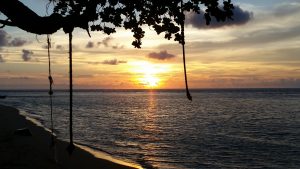The Sun

The Sun is a centre point of Aboriginal and Torres Strait Islander cultures across Australia. Featured on the Aboriginal flag, the Sun is the source of life and death, bringing life and heat to the people. In many Aboriginal traditions, the Sun is a woman and the Moon is a man.
In Yolngu traditions of Arnhem Land in the far north of Australia, the Sun woman is Walu. She lights a small fire each morning, which we see as the dawn. She decorates herself with red ochre, some of which spills onto the clouds, creating the red sunrise. She then lights her torch, made from a stringy-bark tree, and travels across the sky from east to west carrying her blazing torch, creating daylight. As she descends at the end of her journey, again some of the red ochre dusts the clouds to give the red sunset. On reaching the western horizon, she puts out her torch, and starts the long journey underground back to the morning camp in the east. Thus the Yolngu people explained the daily diurnal motion of the Sun across the sky and back again under the ground.
Aboriginal and Torres Strait Islander people marked the rising and setting position of the Sun throughout the year, noting important times that coincide with the solstices and equinoxes. This was accomplished by observing the Sun’s position using landscape features or human-crafted features, such as stone arrangements. Wurdi Youang is a famous example, but others abound.
Even rare solar phenomena were observed, such as solar eclipses, Sun haloes, and parhelia (sun dogs). Current research is exploring these phenomena, so stay tuned for future publications
Learn More
Published Research
- Duane W. Hamacher, Robert, S. Fuller, Trevor M. Leaman and David Bosun (2020). Solstice and solar position observations in Australian Aboriginal and Torres Strait Islander traditions. Journal of Astronomical History and Heritage, 23(1), 89-99.
- Hamacher, D.W. and Norris, R.P. (2011) Eclipses in Australian Aboriginal Astronomy. Journal of Astronomical History and Heritage, Vol. 14(2), pp. 103-114.
- Norris, R.P. and Hamacher, D.W. (2009). The astronomy of Aboriginal Australia. The Role of Astronomy in Society and Culture, edited by D. Valls-Gabaud and A. Boksenberg. Cambridge University Press, pp. 39-47.
- Hamacher, D.W. and Norris, R.P. (2011). “Bridging the gap” through Australian cultural astronomy. Archaeoastronomy and Ethnoastronomy: building bridges between cultures, edited by Clive Ruggles. Cambridge University Press, pp. 282-290.
- Norris, R.P. and Hamacher, D.W. (2011). Astronomical symbolism in Australian Aboriginal rock art. Rock Art Research, Vol. 28(1), pp. 99-106.
- Hamacher, D.W. and Norris, R.P. (2011). Eclipses in Australian Aboriginal Astronomy. Journal of Astronomical History and Heritage, Vol. 14(2), pp. 103-114.
- Norris, R.P.; Norris, P.M.; Hamacher, D.W., and Abrahams, R. (2013). Wurdi Youang: an Australian Aboriginal stone arrangement with possible solar indications. Rock Art Research, Vol. 30(1), pp. 55-65.
- Duane W. Hamacher and Rubina R. Visuvanathan (2018). Twin Suns in Australian Aboriginal Traditions. Journal of Astronomical History and Heritage, Vol. 21(2 & 3), pp. 107-114.
